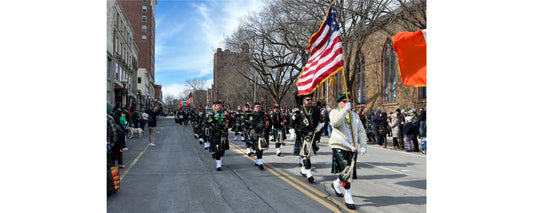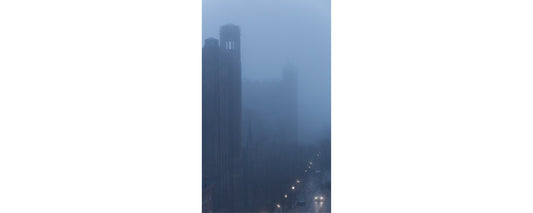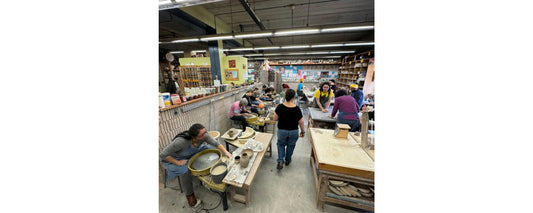Danger lurks in Artspace’s exhibition Between Beauty and Decay, and the dangerous thing is us.
You may sense peril as soon as you step through the gallery doorway’s billowing black curtain—not part of the exhibition, but there to stop the cold. You’ll hear an artist’s soundtrack before you see anything: maybe the maniacal screams that dissolve into laughter from Natalie Ball’s How to Play the Game, or maybe just a train clacking, bells ringing, waves breaking, a machine buzzing, footsteps, birdsong or sound distortions from Basma Alsharif’s video piece Deep Sleep. If you’re like me, you’ll enter unsettled.
There’s beauty here, as the exhibition’s title suggests. Julie Pereira’s Floating Wall #1, for example, is constructed of five hanging tiers of dyed paper in muted shades of beige, orange, gray and green. Though it may look like stone from a distance, this wall is delicate, fragile and shredded at the base, evoking feathers or perhaps flames—result embodying process, as we’re told the artist burned the paper with incense to create its intricate lacework. This piece is cleft down the center, and like the curtain over the gallery’s entryway, it might also be tempting us to walk through, or it might be a paper birth canal from which we’ve already emerged. Either way, it suggests a risky passage through a vulnerable structure.
sponsored by
In the front corner of the gallery, Andrew Erdos’s mixed media pieces crouch like mounds of ice. Mountains I and Mountains II are made of industrial window glass, broken and reconstituted into Arctic pyramids. The pedestal of I is also a mount for four video screens showing time-lapsed scenes of a snowy Monument Valley Navajo Tribal Park, a starry sky and—perhaps most gorgeous of all—a quavering, oil-soaked pool of water. A few droplets of water fall into it, sending concentric ripples through the rainbow slick. Beautiful, yes, but we can’t help acknowledging the ugly connection between our own activities and a threatened natural environment. Unlike in Pereira’s piece, with its subtler suggestion of danger and destruction, this time we’re responsible.
The viewer is most squarely implicated, however, by Tlingit/Aleut artist Nicholas Galanin’s series of four conceptual pieces. Three mirrored boxes, about 15 inches cubed, are set on stands for display. A fourth box is nearly as tall as the gallery space and wide enough to hold a human being. The titles of the works list Tlingit objects—a basket, a rattle, a ceremonial dish, a totem pole—which we’re told are inside the boxes, looking out at us. “The objects inside remain able to see out, placed in a position of power to observe without being on display,” one label explains. Still, we may be tempted to circle the reflective boxes, peering at the glass and seeking a way in. As we do, we see ourselves gawking and coveting that which is not ours to see or to take. Outsiders have done enough taking, it seems.
Galanin is one of four artists in Between Beauty and Decay who identify as indigenous people. A fifth—Chip Thomas, aka Jetsonorama—has worked on a Navajo reservation as a doctor for 30 years. Perhaps naturally, then, endangered cultures form a theme that runs through more of the exhibition. Photographer Kim Weston documents Seminole powwows via blurred multiple exposures that slow the viewer down even as the subjects appear to be in motion. Starr Hardridge’s painting Seismic Premonition, hung in the window on Crown Street, evokes traditional beadwork in an ominous image of a black diamond-backed snake cut into pieces, its pools of blood transforming into flowers.
Supplementing such works is an essay by Artspace gallery director Sarah Fritchey in the exhibition brochure, which begins before the founding of what we call New Haven. “I want to start by acknowledging the life of the place that Artspace occupies in downtown New Haven,” she writes. “We are on Quinnipiac land.”
Curator Erin Joyce’s essay in the brochure asserts that the pieces in Between Beauty and Decay “inspect… dissension, dismantling of power structures and grief in the post-internet landscape.” But the works also speak for themselves, and what they say to me, as I gaze out the gallery windows at the corner of Orange and Crown or into a mirrored box, isn’t pretty: Many of the perils of our world come from within. They come from us.
Between Beauty and Decay
Artspace – 50 Orange St, New Haven (map)
Wed-Sat noon-6pm through Feb 24
(203) 772-2709 | info@artspacenh.org
www.artspacenewhaven.org/…
Written by Kathy Leonard Czepiel. Photographed by Dan Mims.








